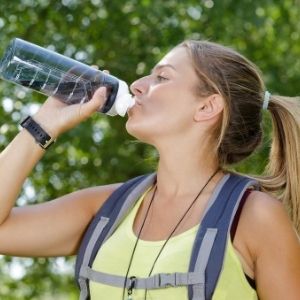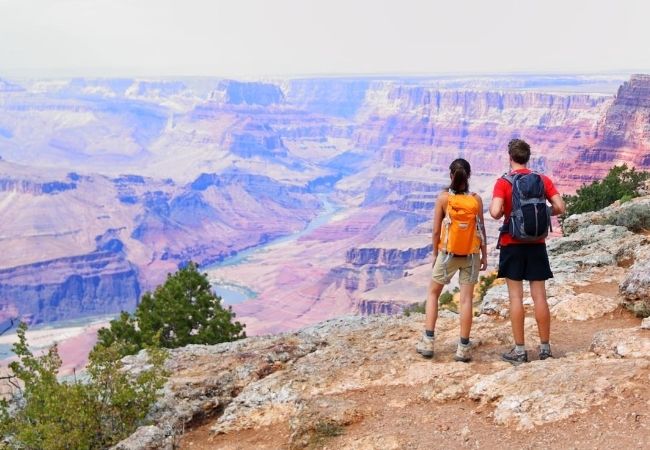Many hikers are excited for the snow to melt, for vacations, and the long days of summer to plan their hikes. Along with summertime though comes the heat. If summer is the prime time for your hiking trips, you will need some tips for hiking in the heat. I wouldn’t say that hot weather hiking is always fun, but there are some things you can do to stay cooler and make it more enjoyable.
This post contains affiliate links. You can read my disclosure here.
Planning Hot Weather Hikes
Planning your hot weather hikes is an important factor in staying cooler when hiking in the heat.
1.Choose a location that will provide some shade. Hike in the woods or canyons that are not exposed to direct sunlight. Higher altitude hikes will also be cooler.
2. Choose a hike near water. Sometimes the slight breeze form the ocean or lake can be a little refreshing. If you will be hiking near a creek or river, you’ll have access to the water to cool off by splashing some water on you or dipping a hat, neck gaitor or shirt in the water.

3. Check the forecast. Obviously you know it will be hot, but if they are calling for record highs, it is during a brutal heat wave, or humidity levels are going to be extremely high, you may want to reconsider and hike on a different day.
Humidity levels play a huge factor in the heat index, making it feel hotter than it is. It can seem like you are walking in a steamy fog!
A common question among newbie hikers is “how hot is too hot to hike?”. Everyone has a different idea of how hot is too hot. I think it largely depends on what you are acclimated to. If you are used to working outside or being outdoors in the heat, hiking in the heat may not bother you as much as someone that stays in the air conditioning all day or lives somewhere that doesn’t experience very much hot weather.
4. Hike in the early morning or late evening. Don’t hike in the hottest part of the day which is usually between 11:00 am to 3:00 pm.
It is cooler in the morning, plus I love watching creation wake up on an early morning hike. If you are starting before sunrise (perfect for sunrise photo ops!) be sure you have your headlamp and flashlight if you will be hitting the trail in the dark.
If you will be hiking during the hottest part of the day, try to plan it so you will be on a section of your hike that is not in the direct sun. That may be easier said than done if you are doing a hike you have never done before and not sure how far you’ll be by a certain time.
What to Wear Hiking in the Heat
5. Choose light colored clothes. Dark colors absorb the heat making you even hotter. Select light colors like white, tan, or pastels to help reflect the sun and heat.
6. Wear loose fitting clothes. Loose clothes will be cooler and are usually more breathable. I personally can’t stand tight fitting shirts, but I know some people prefer snug shirts and tank tops.
7. Purchase moisture wicking fabrics. Synthetic blends (nylon or polyester) and even light weight wool are great.
8. Some people prefer wearing cotton on hot weather hikes – you can wet the shirt and since cotton doesn’t dry quickly, the moisture may help keep you cooler as it evaporates. I don’t know about this theory. Wet cotton is heavy and in the humid south, I sweat alot and never feel dry! The heat and humidity can be downright oppressive!
Related Hiking Post: What to Wear Hiking
9. Some hikers are cooler in lightweight, long sleeve shirts and pants. The extra coverage keeps the sun off your skin, helping prevent sunburn. Some of these shirts have vents on the back and under the arms that allow you to feel a little breeze and extra ventilation. This shirt is lightweight, loose, has long sleeves, and even blocks UV rays. Its available in plus sizes and for men too.
10. Wear clothes that provide UV ray protection. Purchase clothes that are UPF rated to block the sun. You can purchase short and long sleeve shirts and pants or shorts that are UPF rated.
11. Wear a hat. A lightweight, wide brimmed hat is best, but even a ball cap will help protect your head and face. These hats cool instantly when activated with water.
12. Wear a neck gaitor or use a cooling towel. Not only will they protect your neck from the sun, they feel awesome when wet. Many of them cool instantly when activated with water. You can also wear them on your head or like a headband. You can even wet an inexpensive bandana.
13. Wear moisture wicking socks. Choose a quality sock that wicks moisture and dries quickly which will help prevent blisters. I love Darn Tough socks!
Hiking in the Heat
14. Start hydrating before your hike. Don’t start your hike dehydrated. Begin drinking more water several days before your hike. Better yet, just get in the habit of drinking at least 64 ounces of water every day!
15. Drink plenty of water during your hike. Don’t wait until you feel thirsty. Sip on your water though out your hike. Take plenty of water, plus water purification if you will be hiking near a water source.

16. Freeze your hydration bladder before your hike. You can store your empty bladder in the freezer – this helps prevent mold, and you can also freeze it with water in it. The cold bladder against your back feels good, plus your water will stay colder longer.
17. Eat salty snacks. All the sweating and water consumption can deplete your minerals leading to hyponatremia, which is dangerously low sodium levels. Take salty snacks like nuts and pretzels or carry little salt packets or tablets. You can also add electrolytes to your water with a product like Nuun.
18. Wear a necklace fan. This necklace fan hangs around your neck hands free and provides some air.
19. Chafing a problem? Sweat, moisture, material, and friction are a dangerous combination! Use a product like Body Glide or Gold Bond Friction Defense. or a sweat absorbing, anti chafing powder.
20. Hike with an umbrella! If finding shade will be a problem on your hike, you could take a lightweight umbrella to block the sun. This UV blocker umbrella claims that it is 15 degrees cooler under it than the air around you! This Zpacks umbrella weighs only 6.8 ounces, plus you can get a holster to hook it to your backpack.
21. Hike slower. I’m not a fast hiker anyway (raise your hand if you could be a member of the sloth hiking club!), but I feel especially slow in really hot weather. Make a point to not overexert yourself. Know your limits.
22. Take breaks and rest, especially if it is the hotter part of the day. Try to find some shade and cool off for a little while. This is a good time to eat your snack and replenish your electrolytes.
23. Don’t forget to wear sunscreen. You can quickly burn hiking in sun. Apply it before sun exposure and then every couple of hours, especially if you are sweating a lot.
Dangers of Hiking in Hot Weather
I already mentioned hyponatremia, which is fairly rare. A more common danger of hiking in hot weather is heat exhaustion which can lead to heat stroke.
24. Know the signs and treatment of heat exhaustion and heat stroke. Both are usually caused by dehydration when exposed to high temperatures. One of the first signs of dehydration is dark colored urine.
Signs of heat exhaustion:
- Dizziness and faintness
- Pale, cool, clammy skin
- Heavy sweating
- Nausea
- Fatigue
- Rapid heartbeat/pulse
- Muscle cramps
- Headache
What to do if you or someone with you shows signs of heat exhaustion:
- Stop hiking and find a shady place to rest and lay down
- Loosen any tight, restrictive clothes
- Hydrate with electrolytes/salt
- Use cool, wet cloths on face and neck
- Fan with a map or piece of clothing
Signs of heat stroke:
- High body temperature
- Confusion, disoriented, and may have difficulty speaking
- Throbbing headache
- Dizziness
- Fatigue
- Nausea
- Lack of sweating
- Warm, dry, flushed skin
- Rapid pulse/racing heartbeat
- Rapid breathing
- Unconsciousness
Treatment for heat stroke:
- Stop hiking and try to find shady place to lay down and rest. Use a tarp or clothing to provide shade if none is available nearby
- Loosen any tight, restrictive clothing
- Hydrate with water and electrolytes if the hiker is able to drink
- Use cool, wet cloths on the face, neck, arm pits, and groin. If a creek is nearby, place the hiker in the water but only if you can properly support them
- Fan them with a map or clothing
- Evacuate as soon as possible and get medical attention. Heat stroke is serious and life threatening
How do you stay cool hiking in hot weather?
It’s your turn! How do you stay cool hiking in the heat? Do you have any hot weather hiking tips that I missed? Or maybe you just skip hot weather hiking and wait for it to cool down!



